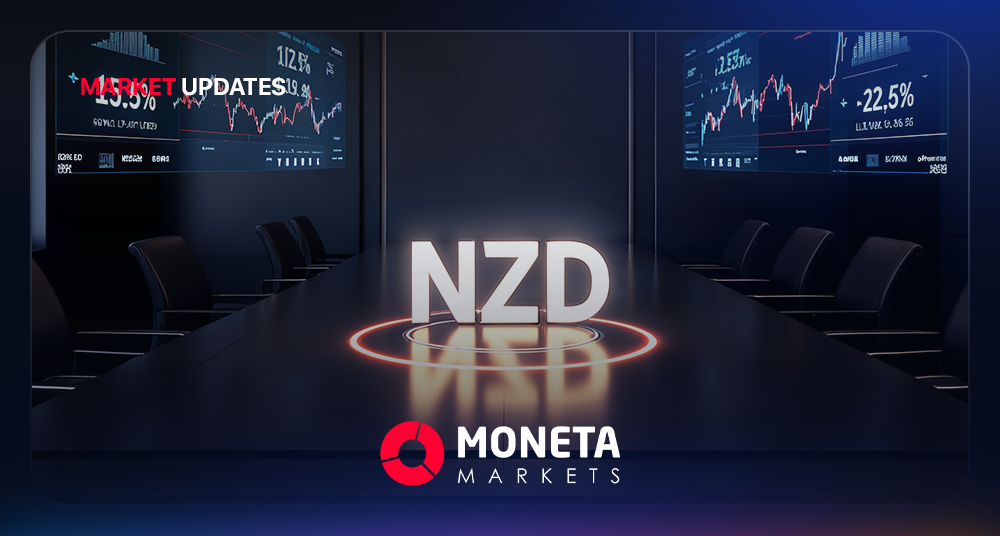Open a live account and start trading in just minutes.
This site uses cookies to provide you with a great user experience. By visiting monetamarkets.com, you accept our cookie policy.
Allow allThis site uses cookies to provide you with a great user experience. By visiting monetamarkets.com, you accept our cookie policy.
Allow all
Global markets are grappling with heightened volatility as the U.S.-China trade war escalates, driven by President Donald Trump’s tariffs and China’s retaliatory measures. Commodity currencies, oil, and equities are under pressure, while safe-haven assets like gold and the Japanese Yen show mixed responses amid recession fears and geopolitical risks.
Key Takeaway:
Trump’s tariffs and China’s retaliation are roiling markets, slamming NZD, CAD, and oil while testing safe-havens like JPY and gold. With recession risks mounting and geopolitical tensions flaring, investors are navigating a high-stakes landscape of uncertainty.

As financial markets kick off April 4, 2025, investors are tuning in for a pivotal day of economic insights, with the U.S. Nonfarm Payrolls (NFP) report looming large. Movements in gold, currencies, and crude oil are reflecting a blend of optimism, caution, and uncertainty, setting the stage for potential shifts depending on the labor market data. Here’s a snapshot of the key developments driving the markets today.
Gold continues to command attention, holding its ground above the $3,100 mark as bullish momentum shows no signs of fading. Investors are increasingly drawn to the precious metal as a safe-haven asset amid global uncertainties, with all eyes now on the forthcoming U.S. NFP report. A weaker-than-expected jobs number could amplify gold’s allure, while a robust outcome might test its recent upward trajectory.
The Pound Sterling is displaying notable staying power, clinging to modest gains against a U.S. Dollar that’s feeling the heat from emerging economic turbulence stateside. Market participants attribute the Dollar’s softness to mixed signals about U.S. growth, with the GBP/USD pair finding support as traders weigh the implications of potential policy shifts. The NFP data could either bolster Sterling’s edge or shift the balance back toward the greenback.
The spotlight is firmly on the U.S. Nonfarm Payrolls report, set to release later today, with analysts forecasting a noticeable slowdown in job creation for March. This anticipated easing comes against a backdrop of economic uncertainty, raising questions about the resilience of the U.S. recovery. Investors are bracing for a range of outcomes, from a mild dip that could calm inflation fears to a sharper decline that might signal deeper challenges ahead.
Crude oil markets are taking a breather, with West Texas Intermediate (WTI) prices adopting a bearish posture as European trading gets underway. This downward tilt reflects a shift in sentiment, possibly driven by concerns over weakening demand or an oversupply outlook. Traders are keeping a close watch on global economic cues, with oil’s direction likely to remain sensitive to both the NFP results and broader geopolitical developments.
Today’s markets are a mixed bag, with gold shining brightly near $3,100 and the Pound Sterling eking out gains against a faltering U.S. Dollar. Meanwhile, crude oil’s bearish turn contrasts with the broader wait-and-see mood. The U.S. NFP report remains the day’s main event, poised to sway sentiment across asset classes as investors gauge the health of the U.S. economy and its global ripple effects.

Daily Market Update: April 4, 2025 Overview:April 4, 2025, Wall Street experienced a tumultuous session, closing with significant losses as fears mounted over the economic fallout from President Donald Trump’s newly imposed tariffs. The sweeping trade measures, including a baseline …

As we step into April 3, 2025, global financial markets are reacting to a mix of geopolitical developments and economic shifts. From precious metals hitting new highs to currency fluctuations driven by tariff announcements, today’s market landscape reflects a cautious, risk-off sentiment. Here’s a detailed look at the key movements shaping the day.
Gold continues its relentless climb, reaching fresh record highs near $3,167 per ounce, surpassing the key resistance level of $3,142. The precious metal’s rally is fueled by unabated buying amid a prevailing risk-off mood in global markets. Investors are flocking to gold as a safe-haven asset, with support holding firm above $3,073, and analysts eyeing a potential move toward $3,252 if momentum persists. The surge underscores heightened uncertainty, likely driven by recent trade policy developments and macroeconomic concerns.
The Japanese yen has spiked to a multi-week high against the U.S. dollar, a move triggered by President Trump’s latest tariff announcements. These tariffs, aimed at reshaping global trade dynamics, have introduced volatility into currency markets. The yen’s appreciation reflects its status as a safe-haven currency amid growing trade war fears, putting downward pressure on the USD/JPY pair. Traders are closely monitoring further policy signals, as the yen’s strength could signal broader shifts in risk appetite.
In contrast to gold’s bullish run, silver has pulled back, with the XAG/USD pair falling to around $33.00. After failing to sustain upward momentum, silver appears to be entering a phase of consolidation. Market observers note that further sideways movement cannot be ruled out, as traders weigh the metal’s industrial demand against its safe-haven appeal. The divergence between gold and silver highlights differing investor priorities in the current environment.
The Indian rupee faced pressure as the USD/INR pair jumped following Trump’s imposition of a 26% tariff directed at India. The currency pair bounced off support between 85.36-85.38, climbing to test resistance at 85.70, with sights now set on the 86.00 level. This tariff escalation has rattled markets, raising concerns about India’s export-driven sectors and adding to the rupee’s volatility. The move underscores how targeted trade policies are rippling through emerging market currencies.
Global markets are navigating a complex landscape on April 3, 2025. Equities are under pressure as trade war fears resurface, with major indices reflecting a cautious stance among investors. The U.S. dollar is experiencing mixed performance—weakening against safe-haven currencies like the yen while gaining ground against emerging market currencies like the Indian rupee. Precious metals remain a focal point, with gold leading the charge as a hedge against uncertainty, though silver’s pullback suggests some profit-taking. Bond yields are steady but sensitive to tariff-related developments, while commodities are showing mixed responses to the shifting trade outlook. Overall, the market tone is one of heightened vigilance, with participants bracing for further policy announcements and economic data to guide the next moves.

Global financial markets are navigating a landscape of caution and anticipation as investors brace for US President Donald Trump’s impending announcement on reciprocal tariffs. The uncertainty surrounding these tariffs is driving divergent performances across asset classes, with safe-haven assets like silver gaining momentum while risk-sensitive commodities such as oil face downward pressure.
The Yen is exhibiting weakness against the US Dollar, trading with a negative bias. This trend may be fueled by investors gravitating toward the USD as a safe haven or by concerns over the potential impact of tariffs on Japan’s export-driven economy. From a technical standpoint, USD/JPY is teetering in the 150.00 region.
In contrast, the NZD is defying the broader market caution, advancing to a fresh weekly high around 0.5720-0.5728 against the USD. This resilience could be attributed to New Zealand’s strong economic fundamentals or its ties to commodity markets, which are experiencing mixed signals. The pair is nearing significant resistance at 0.5760; a decisive move above this level could pave the way for additional gains.
Silver rose to $33.85 on Wednesday, driven by safe-haven demand amid concerns over US President Donald Trump’s tariff plans, which could escalate the global trade war and slow the economy. Technical indicators, including support above the 100-day EMA and a 14-day RSI near 57.80, suggest a bullish trend with potential gains targeting $34.23 and the $34.60-$34.70 zone.
WTI Oil edges up to around $70.95 in early Asian trading on Wednesday, lifted by supply concerns following Trump’s tariff threats against Russia and Iran. Geopolitical risks, including potential disruptions from tariffs on Russian oil and actions against Iran’s nuclear program, support prices. However, the upside is tempered by a 6.037 million barrel rise in US crude stockpiles last week and anticipation of Trump’s reciprocal tariffs announcement.
As the market awaits the details of Trump’s reciprocal tariffs, volatility is expected to remain elevated. Should the tariffs prove more aggressive than anticipated, safe-haven assets like silver and the USD could see further inflows, while riskier assets such as oil and commodity-linked currencies might face intensified selling pressure. On the other hand, if the tariffs are milder or include significant exemptions, risk appetite could rebound, potentially lifting oil prices and supporting currencies like the NZD.
In summary, today’s market dynamics underscore the pivotal role of the upcoming tariff announcement in shaping investor sentiment. Traders are advised to monitor key technical levels and remain agile in response to new developments.

Global financial markets are treading cautiously as investors brace for a pivotal week featuring significant events such as RBA Governor Michele Bullock’s speech and an impending US tariff showdown. Safe-haven assets like gold and the Japanese yen are drawing attention, while cryptocurrencies, notably TRON, exhibit heightened volatility. Below is a comprehensive analysis of key asset classes based on the latest developments.
Markets are in a state of heightened vigilance as key events unfold. Gold and the Japanese yen are capitalizing on safe-haven demand, while the Australian dollar and euro remain in a holding pattern pending directional cues from the RBA speech and tariff negotiations. Meanwhile, TRON’s sharp rally underscores the crypto market’s sensitivity to regulatory and transactional catalysts. With volatility on the horizon, traders are poised for action as these developments play out.

As global markets continue to adjust to evolving economic conditions, currency pairs and commodities are reacting to shifting risk sentiment, economic indicators, and central bank expectations. Traders are closely monitoring the latest developments in key assets such as the US Dollar, gold, oil, and major currency pairs like EUR/USD and NZD/USD for potential opportunities and risk management.
Gold prices have surged to a record high, with spot gold reaching $3,086 per ounce. This increase is driven by escalating trade tensions following U.S. President Donald Trump’s announcement of a 25% tariff on auto imports, effective next week. Investors are flocking to safe-haven assets like gold to hedge against the uncertainties of a potential global trade war. Analysts suggest that the next target for gold could be $3,100 per ounce, as economic risks and geopolitical conflicts continue to support the bullish trend.
The New Zealand dollar (NZD) is anticipated to continue trading within a defined range against the U.S. dollar (USD). Market analysts project that the NZD/USD pair will remain range-bound, with no clear directional bias in the immediate term. Investors are advised to monitor economic indicators and central bank communications for potential catalysts that could influence the pair’s movement.
The Australian dollar (AUD) is expected to trade between 0.6275 and 0.6320 against the U.S. dollar (USD). Analysts suggest that the AUD/USD pair will likely remain within this range, reflecting a period of consolidation amid prevailing market conditions. Traders should keep an eye on developments in global trade policies and domestic economic data releases for insights into potential shifts in the pair’s trajectory.
The British pound (GBP) experienced a brief uptick following the release of February retail sales data, which showed an unexpected 1.0% increase from January, defying economists’ predictions of a 0.4% decline. This surprising retail performance offered some positive insight into consumer resilience. Following the data release, the pound reached a session high of $1.295, but later settled at $1.2944, showing little overall change. Concurrently, the euro was slightly down against the pound to 83.34. Additionally, the UK economy grew by 0.1% in the fourth quarter of 2024, in line with expectations, and saw a 1.5% annual growth, marginally surpassing the forecasted 1.4% increase.
Global markets are on edge as the implementation of new U.S. tariffs fuels fears of a deepening trade war. Asian stocks have experienced significant declines, with Japan’s Nikkei and South Korea’s benchmark index both dropping around 2%. European and U.S. stock futures also point downward, indicating widespread investor anxiety. The U.S. dollar remains steady ahead of an upcoming inflation report, while the yen has strengthened on expectations of potential rate hikes by the Bank of Japan. Oil prices have seen slight declines due to concerns over the impact of new tariffs on the global economy.

As global markets continue to adjust to evolving economic conditions, currency pairs and commodities are reacting to shifting risk sentiment, economic indicators, and central bank expectations. Traders are closely monitoring the latest developments in key assets such as the US Dollar, gold, oil, and major currency pairs like EUR/USD and NZD/USD for potential opportunities and risk management.
The New Zealand dollar (NZD) has strengthened, trading above the 0.5700 mark against the US dollar (USD). This rise is attributed to a renewed bullish sentiment, with the NZD/USD pair finding initial resistance near the nine-day Exponential Moving Average (EMA) at 0.5750. Technical analysis indicates a strengthening bullish bias, supported by the 14-day Relative Strength Index (RSI) remaining above 50. Key support levels are identified at the 50-day EMA around 0.5717, with potential for further gains if the pair maintains momentum above this threshold.
The Euro (EUR) is experiencing downward pressure against the US dollar, with forecasts suggesting a possible pullback toward the 1.0725 level. This projection is based on technical analysis and current market dynamics, including recent tariff threats by US President Trump and dovish commentary from the European Central Bank (ECB). Traders are advised to monitor upcoming US data releases and Federal Reserve communications for further insights into potential EUR/USD movements.
Gold continues to trade above the $3,000 threshold, supported by a positive risk tone in the market. While bullish conviction appears limited, the metal’s ability to hold above this level reflects ongoing demand amid economic uncertainties. Investors are advised to remain cautious, as market sentiment can be volatile, and geopolitical developments may influence gold’s trajectory.
Crude oil prices are showing bullish momentum as European markets open, driven by factors such as supply concerns and geopolitical tensions. The market is closely monitoring inventory data and OPEC+ production decisions, which are expected to influence price movements in the coming sessions. Traders should stay informed on global demand forecasts and any developments that could impact oil supply dynamics.
Market volatility remains a dominant theme as investors react to ongoing geopolitical developments, inflation concerns, and central bank policies. In the currency market, the US Dollar continues to assert strength against its major counterparts, while commodities such as gold and crude oil remain sensitive to changes in risk sentiment and supply concerns.
In the equity markets, investor focus is on upcoming economic data releases and central bank signals. The outlook for risk assets is clouded by global inflationary pressures, ongoing supply chain disruptions, and the uncertain trajectory of global economic recovery. As central banks worldwide adjust their monetary policies to navigate these challenges, market participants remain cautious, closely watching inflation trends and upcoming policy decisions.

Global markets remain volatile as currency fluctuations and central bank expectations drive investor sentiment. Gold is consolidating above $3,000, while the Japanese yen weakens, and the Australian dollar gains support ahead of the RBA’s April meeting. The EUR/GBP pair remains under pressure near recent lows.
The Japanese yen has depreciated to its lowest level in three weeks against the US dollar. A combination of dovish monetary policy expectations from the Bank of Japan and a relatively stronger greenback has contributed to this decline. However, the lack of follow-through selling suggests that traders are waiting for further cues, including US economic data and any policy shifts from the BOJ.
The Australian dollar is showing resilience as traders anticipate that the Reserve Bank of Australia (RBA) will keep interest rates unchanged in its April meeting. While inflation remains a concern, the RBA has signaled a cautious approach to further tightening, which is providing near-term support for the currency. Market participants are closely watching domestic labor data and global risk sentiment for additional direction.
Gold prices are holding steady above the $3,000 mark, with downside risks appearing limited despite some consolidation. Investors continue to seek gold as a safe-haven asset amid ongoing geopolitical concerns and inflationary pressures. While profit-taking has caused some price fluctuations, strong demand for the metal is keeping it well-supported. Traders are now looking toward US Federal Reserve commentary for potential signals on future interest rate policy, which could impact gold’s trajectory.
The EUR/GBP pair is consolidating above the mid-0.8300s, struggling to regain momentum after touching a three-week low on Monday. The euro remains under pressure due to economic uncertainty in the Eurozone, while the British pound is finding some stability on expectations of a steady Bank of England policy. Market focus is on upcoming economic releases, including UK inflation data, which could influence the pair’s next move.
Global markets remain sensitive to monetary policy shifts and economic data. Equity markets are mixed as investors assess inflation trends, central bank outlooks, and geopolitical risks. The US dollar continues to show strength against weaker currencies, while commodities like gold and oil remain volatile amid supply concerns and shifting risk sentiment.

Global markets are experiencing mixed movements as the US dollar weakens, commodities remain volatile, and investors assess risk sentiment. Gold has pulled back after briefly surpassing $3,000, while oil prices continue to climb amid supply concerns. The NZD/USD pair is facing key resistance, and the dollar index appears vulnerable to further declines.
The US Dollar Index (DXY) has fallen below 104.00, signaling potential further downside. A combination of softer economic data, shifting risk sentiment, and global trade concerns is putting pressure on the greenback. Investors are closely monitoring upcoming data releases for signs of economic resilience.
After briefly touching record highs above $3,000, gold prices have pulled back as risk appetite improves. While safe-haven demand remains a key driver, investors are watching for any shifts in the Federal Reserve’s policy stance that could impact the metal’s outlook.
The New Zealand dollar is attempting to push higher but faces strong resistance near the 0.5750 level, which aligns with its nine-day EMA. A successful breakout could open the door for further gains, but sellers remain active at this level.
WTI crude oil prices continue to rise, supported by strong US demand and geopolitical tensions. With supply risks remaining in focus, oil traders are eyeing further upside, though potential demand slowdowns in major economies could limit gains.
Markets remain sensitive to shifting economic data, central bank policies, and geopolitical developments. Equity markets are showing mixed performance as investors weigh inflation trends and interest rate expectations. Commodities are experiencing volatility, driven by supply chain concerns and shifting global demand. Meanwhile, forex markets are responding to central bank signals and broader risk sentiment. As uncertainty persists, investors continue to seek clarity on growth prospects and potential monetary policy shifts.
Open a live account and start trading in just minutes.
Fund your account using a wide range of funding methods.
Access 1000+ instruments across all asset classes
CFDs are complex instruments and come with a high risk of losing money rapidly due to leverage. You should consider whether you understand how CFDs work and whether you can afford to take the high risk of losing your money. Trading derivatives is risky. It isn't suitable for everyone; you could lose substantially more than your initial investment. You don't own or have rights to the underlying assets. Past performance is no indication of future performance and tax laws are subject to change. The information on this website is general in nature and doesn't consider your personal objectives, financial circumstances, or needs. Please read our legal documents and ensure that you fully understand the risks before you make any trading decisions.
The information on this site is not intended for residents of Canada, Cyprus, France, Spain, Russia, Ukraine, Italy, the United States, or use by any person in any country or jurisdiction where such distribution or use would be contrary to local law or regulation.
Moneta Markets is a trading name of Moneta Markets (Pty) Ltd, an authorised Financial Service Provider (“FSP”) registered and regulated by the Financial Sector Conduct Authority (“FSCA”) of South Africa under license number 47490 and located at 1 Hood Avenue, Rosebank, Johannesburg, Gauteng 2196, South Africa. Company Registration Number: 2016 / 063801 / 07. Contact Phone Number: +27 (10) 1429139. Operational Office: Unit 7, 31 First Avenue East, Parktown North, Gauteng, Johannesburg, 2193, South Africa.
Mmonexia Ltd, facilitates payment services to the licensed and regulated entities within the Moneta Markets Organizational structure.
Mmonexia Ltd registered in the Republic of Cyprus with registration number HE436544 and registered address at Archbishop Makarios III, 160, Floor 1, 3026, Limassol, Cyprus. Mmonexia Ltd, facilitates payment services to the licensed and regulated entities within the Moneta Markets Organizational structure.
Moneta Markets Limited. Business Registration Number:72493069. Registration Address: Flat/RM A 12/F ZJ 300, 300 Lockhart Road, Wan Chai, Hong Kong. Contact Phone Number: +852 37522556. Operational Office: Unit 1201, 12/F, FWD Financial Centre, 308 Des Voeux Road Central, Sheung Wan, Hong Kong.
Moneta Markets is a trading name of Moneta Markets (Pty) Ltd, an authorised Financial Service Provider (“FSP”) registered and regulated by the Financial Sector Conduct Authority (“FSCA”) of South Africa under license number 47490 and located at 1 Hood Avenue, Rosebank, Johannesburg, Gauteng 2196, South Africa. Company Registration Number: 2016 / 063801 / 07. Contact Phone Number: +27 (10) 1429139. Operational Office: 31 First Avenue East, Parktown North, Gauteng, Johannesburg, 2193, South Africa.
Moneta Markets is a trading name of Moneta Markets Ltd, registered under Saint Lucia Registry of International Business Companies with registration number 2023-00068.
Mmonexia Ltd registered in the Republic of Cyprus with registration number HE436544 and registered address at Archbishop Makarios III, 160, Floor 1, 3026, Limassol, Cyprus.
Moneta Markets PTY LTD soliciting Business from UAE through a Non-Exclusive Introducing Broker Agreement Regulated by SCA , Sterling Financial Services LLC ,Cat 5 ,No 305029
Moneta Markets is a trading name of Moneta Markets (Pty) Ltd, an authorised Financial Service Provider (“FSP”) registered and regulated by the Financial Sector Conduct Authority (“FSCA”) of South Africa under license number 47490 and located at 1 Hood Avenue, Rosebank, Johannesburg, Gauteng 2196, South Africa. Company Registration Number: 2016 / 063801 / 07. Contact Phone Number: +27 (10) 1429139. Operational Office: 31 First Avenue East, Parktown North, Gauteng, Johannesburg, 2193, South Africa.
Moneta Markets is a trading name of Moneta Markets Ltd, registered under Saint Lucia Registry of International Business Companies with registration number 2023-00068.
Mmonexia Ltd registered in the Republic of Cyprus with registration number HE436544 and registered address at Archbishop Makarios III, 160, Floor 1, 3026, Limassol, Cyprus.
Moneta Markets PTY LTD soliciting Business from UAE through a Non-Exclusive Introducing Broker Agreement Regulated by SCA , Sterling Financial Services LLC ,Cat 5 ,No 305029